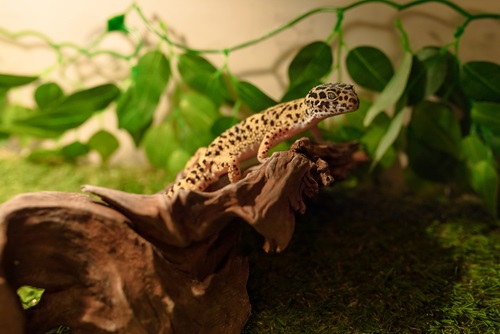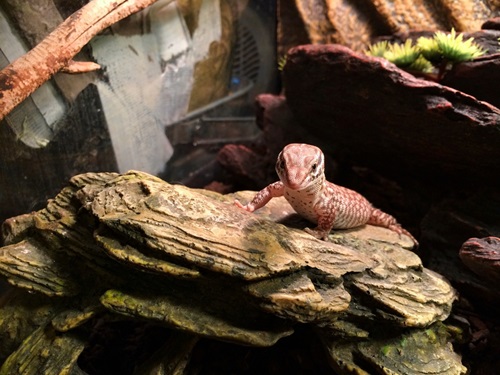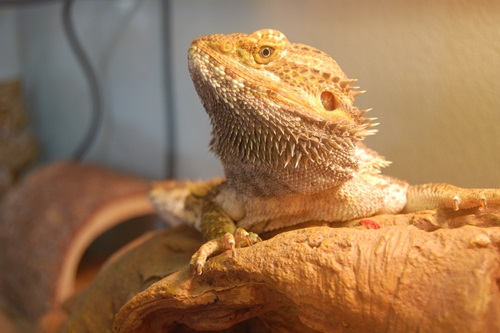How to Set Up a Reptile Tank
Before you bring home a new pet reptile, you want to set up their new tank so your tiny dino feels right at home. Whether you have a snake, turtle, or lizard, setting up a cozy reptile tank is similar for all reptiles — you want to mimic their natural habitat as much as possible. Here's a look at what you need to help your reptile have a healthy and happy life.

Picking the Tank
Whether you call your reptile tank a vivarium or terrarium, choose a tank that is big enough to accommodate your cold-blooded buddy when they're fully grown. For example, snakes might need a tank about 1.5 times their adult length, while crested geckos might prefer a taller tank that allows them to climb.
Be sure you research your particular species to ensure you're providing them with the best tank environment possible. Terrestrial animals, like turtles, will need more floor space. Reptiles used to living in trees, like some lizards or snakes, will want more height.
Pro Tip: Ensure all tank doors and openings can be securely locked. You'd be surprised how easily some reptiles, like snakes, can escape.
Lighting Should Mimic Day & Night
Getting the UV lighting right is vital to creating a cozy reptile tank. Keep the lights on a 12-hour-on/12-hour-off cycle to help mimic nature's day and night rhythm.
But what type of ultraviolet light should you use? Reptiles need both UVA and UVB light. UVA mimics sunlight and helps reptiles regulate their schedule for feeding and daytime movement. It's also important to keep their endocrine system healthy, and a lack of UVA light can affect the mood and behaviors of pet reptiles. UVB, on the other hand, helps with vitamin D3 synthesis. Reptiles that are most active during the day (diurnal) may need higher-output UVB bulbs, but all reptiles need at least some UVB light.
Fun Fact: Reptiles can actually see UVA light, and it changes how they view the world.

Heating Needs Can Vary
Reptiles are cold-blooded, so they need heat sources to help them regulate their body temperature. But their specific heating needs vary by species. Some need more direct contact with heat, such as a heat mat or heat tape. Others are content if you use a dual-purpose bulb that offers heating and UV light. If you use a dual-purpose bulb, you may need a nighttime heat source too. But check with your local, reputable reptile shop; some reptiles benefit from cooler evening temps, so a secondary heat source may not be needed.
In nature, reptiles bask in the sun when they need warmth and move into the shade to cool down. To mimic this, place the heat lamp on one end of your tank, so your reptile can move between warmer and cooler spots. Be sure to set up two thermometers on either side of the tank. Using two thermometers can help ensure both the cooler and warmer ends remain in a healthy and safe range for your cold-blooded buddy.
Humidity is an important part of your pet reptile's environment, so it's important to manage the humidity levels in your tank. And tropical species need more humidity than desert ones. You can typically maintain the proper humidity by misting the enclosure and water bowls daily, or by using a mister or fogger.
To find out your species' ideal temperature range, heating needs, and humidity levels, download our Habitat Guide.
Choosing a Substrate
Finding the right substrate is also vital to creating a cozy reptile tank. "Substrate" refers to the bedding or other substance that covers the bottom of the reptile's cage. A good substrate helps with temperature control, humidity, and creating an environment that feels like their natural home.
Choose bedding that is easy to clean and safe for your tiny dinosaur. Reptile carpeting (or terrarium liner) is one option that may have a pleasing appearance. Or you may prefer a more natural dirt substrate or a desert blend that mimics sand. It's best to avoid bedding with shavings that can irritate your cold-blooded buddy's skin, get stuck in their mouth, or cause digestion issues.
The easiest solution is to choose a specially designed substrate made just for your particular species. Check out our Bedding Guide, which lists the exact bedding blends that are ideal for specific reptile species.
Decorating Your Reptile Tank

Now that you've figured out the lighting, heat, and substrate for your tank, it's time for the fun stuff — the decor!
First, a quick word of caution. Don't use any "tank furniture" that's sharp or can damage your tiny dinosaur's skin. Lava rocks, for example, are not a good choice. But there are still a lot of great options to choose from.
Rocks with softer edges, plants (artificial or live), branches, hollow trunks, or artificial decor designed specifically for reptiles are all good choices. If using live plants, make sure you choose varieties safe for your reptile species. You'll need to do some research to determine which plants are safe, as this can vary depending on the species.
As you set up the decor, try to mimic their natural environment, giving your little dragon places to hide, bask under a warm light, or climb. Be sure the decor is stable, to keep your pet safe and injury-free. Consider angling branches under the basking light to give your reptile options for where they want to sit for optimal warmth and to regulate their body temp.
If you're not sure where to start with your decor choices, check out our Care Sheets for a variety of different species.
Once you have the temperature, lighting, substrate, and decor figured out, all that's left is getting the most nutritious food for your reptile. Setting up a warm, inviting reptile tank may take some time, but it's worth it. When you see your cold-blooded buddy thriving in their home, you'll be glad you made the effort.
Worry Free is a registered trademark of Central Garden & Pet Company.
